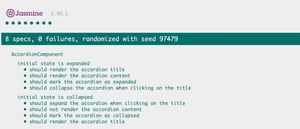Testing Frameworks like Vitest, Jest and Jasmine provide a describe() function. It is useful to group your tests into logical groups. The function can be nested to create a hierarchy of tests and make the tests more readable.
In Angular for example, you will have the following spec file when creating a new component:
describe("AccordionComponent", () => {
it("should create", () => {
// ...
});
});Instead of adding a lot of it() calls with long descriptions you can create multiple describe() blocks.
describe("AccordionComponent", () => {
describe("initial state is expanded", () => {
// Mock data, test utils, etc. for this describe() block
const initiallyExpanded = true;
it("should render the accordion title", () => {
// ...
});
it("should render the accordion content", () => {
// ...
});
it("should mark the accordion as expanded", () => {
// ...
});
it("should collapse the accordion when clicking on the title", () => {
// ...
});
});
describe("initial state is collapsed", () => {
it("should render the accordion title", () => {
// ...
});
it("should not render the accordion content", () => {
// ...
});
it("should mark the accordion as collapsed", () => {
// ...
});
it("should expand the accordion when clicking on the title", () => {
// ...
});
});
});Jasmine shows all describe() blocks in the output and nests them in a tree structure.
